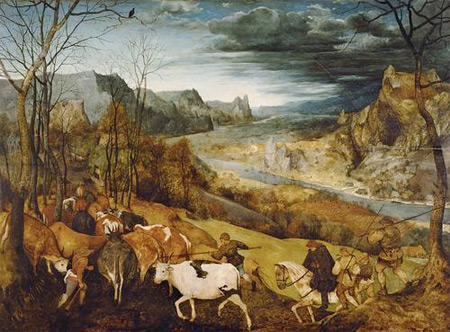
The cool wind coming in from the north, the piles of dead leaves crunching under foot, the sun that hangs lower in the sky with each passing day. It is easy to forget that all these changes used to point to something. The approach of autumn was the transformation in a mode of life, moving us from the work of the last days of the harvest to the hunkering down in preparation for winter.
It is amazing, even now, how quickly the shift in seasons stimulates a transformation of mood. The mind is pulled along by forces lurking in the weather—in the sun and the moon, in the otherwise-unnoticed messages from the grass and the trees. We are changing, they say, and so shall you. You simply can’t feel the same on an autumn day as you might feel on one of those bright, intrusive days of early spring. That’s what Keats was getting at in his “Ode to Autumn”:
Where are the songs of Spring? Ay, where are they?
Think not of them, thou hast thy music too,—
Spending, as I am, the last days of summer and the emergent days of autumn in the Flemish parts of Northern Europe, I can’t help thinking of the paintings of Peter Breugel the Elder. He didn’t paint the seasons as merely aesthetic motifs. He painted them as actors, as entities with agency. The seasons make you do things, literally. They make you feel one way and not another, literally. Bruegel managed to paint the compulsion.
It is impossible to stare at Bruegel’s autumnal painting “Return of the Herd,” for more than a minute or two without becoming autumn-minded in your own head. The dark clouds are creeping this way across the horizon. The animals — careless beasts! — must be rounded up and brought back over the hills. The barren trees at this crest compel one to pull the coat a little tighter and cuddle into oneself even if the temperature does not fully warrant it yet. That is what Fall want from us, and the body submits.
I particularly like how the spots of sunshine in the painting act as fragments of memory embedded in the landscape. How quickly summer has faded. But there she is for a moment when the sun hits the still-beiged fields in a glancing blow between cloud formations. Summer still winks a few goodbyes. That is why Fall is a between-season, while Winter and Summer are not. Who knows why? They were just made that way.
Autumn no longer dominates us in the way that Bruegel understood it and painted it. There is human achievement in this fact, as well as indefinable loss. Being less at the mercy of the cruel cycles of nature means being more at the mercy of our selves. Shall we call this an ambivalent trade-off? Anyway, it is not hard, even with all the historical changes, to receive the visceral impact of Bruegel’s painting. We can still feel the seasonal call, the all-encompassing shift in the mood and way of things that Bruegel gives us with his landscape, a few peasants, and the slowly roaming cows. In that, at least, it is the same autumn as it ever was. • 29 September 2010



